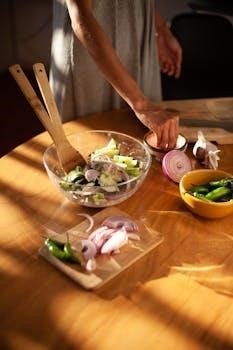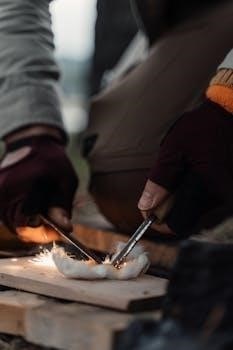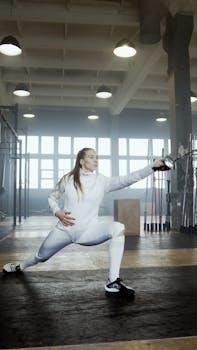one handed dressing techniques pdf
- Published
- in PDF
One-Handed Dressing Techniques⁚ An Overview
This section provides an introduction to dressing independently using one hand. The focus is on adapting techniques and utilizing assistive devices to overcome challenges. Our goal is to increase independence. We aim to provide knowledge and skills for individuals with limited mobility.
Dressing with one hand can present unique challenges, but with adapted techniques and assistive tools, independence is achievable. This section introduces the principles of one-handed dressing. It emphasizes the importance of planning, preparation, and selecting appropriate clothing. Mastering these techniques can significantly improve a person’s self-esteem and quality of life. Individuals facing physical limitations due to stroke, injury, or other conditions can greatly benefit. Occupational therapists play a key role in teaching these techniques and recommending suitable adaptive equipment. The goal is to empower individuals. We aim to help them regain control over their daily routines, enhancing independence.

Pre-Dressing Tips and Considerations
Before starting, consider clothing choices and accessibility. Planning your outfit and laying out clothing simplifies the dressing process. Addressing arm placement is crucial for comfort and ease. Prioritizing these steps aids independence.
Dressing the Affected Arm First
Always begin by dressing the affected arm first. This approach simplifies the process and prevents unnecessary strain. Position the garment so the affected arm’s sleeve is easily accessible. Place the affected hand gently into the sleeve. Use the stronger hand to guide the garment up the arm. Ensure the fabric is smooth and not twisted. Once the affected arm is in place, you can maneuver the rest of the garment. Supporting the affected arm on a pillow aids in comfort and stability. Dressing the affected side first establishes a foundation. This allows for easier manipulation with the functional arm. This reduces the risk of injury.
Choosing Appropriate Clothing
Selecting appropriate clothing is crucial for easy one-handed dressing. Opt for open-front garments like shirts and cardigans. These are generally easier to manage. Loose-fitting jackets can slip over the shoulder with minimal effort. Elasticated waists in pants and skirts are preferable to buttons and zippers. Consider clothing with simple closures such as Velcro. Avoid tight or restrictive clothing that limits movement. Choose fabrics that are easy to grip and manipulate. Pre-plan your outfit to reduce decision fatigue. Adaptive clothing with modified closures can further simplify dressing. Prioritize comfort and functionality. Clothing should promote independence and confidence. Consider the weather and activity level when choosing clothing.
Upper Body Dressing Techniques
This section details methods for dressing the upper body with one hand. It covers techniques for both open-front and pullover garments. Specific instructions are given to maximize independence and ease the dressing process.
Dressing Open-Front Garments
Dressing in open-front garments, like shirts and cardigans, can be simplified with these one-handed techniques. Begin by laying the garment on a flat surface with the inside facing up and the collar towards you. Place the affected arm into the sleeve first, using your stronger arm to guide it. Next, bring the garment around your back and insert your strong arm into the remaining sleeve. Once both arms are in, use your stronger hand to pull the garment across your chest and button or zip it up. Consider using adaptive tools like button hooks if needed. Ensure a comfortable and secure fit.
Dressing Pullover Garments
Putting on pullover garments, such as t-shirts and sweaters, can be made easier using specific one-handed techniques. Begin by laying the garment face down on a flat surface with the collar facing you. Fold the bottom edge of the garment up towards the collar, creating a cuff. Sit down and position the cuffed edge over your head, allowing it to rest on your shoulders. Next, insert your affected arm into the armhole, pulling the sleeve up as far as possible. Then, use your stronger arm to guide the other arm into its respective sleeve. Finally, pull the garment down over your body, adjusting as needed for comfort and fit.

Lower Body Dressing Techniques
This section will explore strategies for dressing the lower body with one hand. We will cover techniques for managing pants, skirts, and undergarments. Adaptive equipment options will also be reviewed. The aim is independent dressing.
Managing Elasticated Waists
Elasticated waists offer a significant advantage when dressing with one hand. Their inherent stretch and flexibility eliminate the need for complex fasteners, such as buttons or zippers, making them easier to manage. To don elasticated waist pants or skirts, begin by sitting comfortably. Gather the garment and widen the opening. Place your stronger hand inside the waistband and guide one leg into the opening, pulling the garment up as far as possible. Repeat with the other leg.
Once the garment is around your thighs, use your hand to pull it up over your hips and towards your waist. Adjust the waistband for comfort and even distribution. For removal, reverse the process, pulling the garment down over your hips and legs. Elasticated waists promote independence and ease in dressing.
Adaptive Equipment for Lower Body Dressing
Several adaptive tools can greatly assist with lower body dressing when using only one hand. Reachers, featuring a long handle with a gripping mechanism, extend your reach and eliminate bending, aiding in pulling up pants or skirts. Sock aids simplify putting on socks by holding them open, allowing you to slide your foot in easily. Dressing sticks, with a hook or loop at the end, help maneuver clothing over your legs and feet.
Button hooks assist with fastening buttons on pants or skirts. Leg lifters can help lift a weak or immobile leg to facilitate getting dressed. These devices promote independence and reduce strain during dressing. Occupational therapists can provide guidance on selecting and using appropriate adaptive equipment for individual needs. The Independent Living Centre Tasmania gives advice about assistive technology.

Specific Clothing Items
This section focuses on techniques for managing specific clothing items independently with one hand. We address strategies for bras and shoelaces, often challenging. Detailed instructions and alternative methods are provided, promoting self-sufficiency. We aim to make it easier.
Fastening Bras One-Handed
Fastening a bra with one hand can be particularly challenging. A recommended technique involves fastening the bra at the front of your body first. Once fastened, rotate the bra around to the back, carefully maneuvering each arm through the straps. If this proves difficult, consider using front-fastening bras, as they eliminate the need to reach behind. Adaptive bras with Velcro closures are also available. These often simplify the fastening process significantly. Practicing in front of a mirror can help you visualize the steps and improve your technique. Don’t hesitate to seek assistance from an occupational therapist for personalized guidance. They can offer tailored solutions.
Tying Shoelaces One-Handed
Tying shoelaces with one hand requires adaptation and practice. One method involves knotting one end of the shoelace and lacing the shoe, leaving the knot at the bottom eyelet. Thread the other end through the top eyelet from outside to inside, then throw it over the laces. Use your ring, index, middle finger, and thumb to tighten the bow. Several online videos demonstrate this technique. Alternatively, consider using elastic shoelaces, which eliminate the need for tying altogether. Adaptive devices, like shoelace fasteners, can also be helpful; Practice regularly and be patient. Consider using a table or your leg to hold the shoe steady. Occupational therapists can help teach alternative methods.

Additional Resources and Support
This section provides links to occupational therapy resources and assistive technology. The resources will help you learn more about one-handed dressing techniques. Support groups and online forums offer peer support and shared experiences.
Occupational Therapy and Handouts
Occupational therapists play a vital role in teaching one-handed dressing techniques. They assess individual needs and develop personalized strategies to promote independence. Therapists offer guidance on adaptive equipment and clothing modifications. They provide training on compensatory techniques and problem-solving skills.
Handouts and visual aids reinforce therapy sessions and serve as references for patients and caregivers. These materials outline step-by-step instructions and illustrate effective dressing methods. They offer practical tips and solutions to common challenges encountered during dressing.
Consult an occupational therapist for individualized assessments, tailored interventions, and comprehensive resources to enhance dressing independence. They can provide support and guidance to promote self-sufficiency and improve quality of life.
Assistive Technology and Dressing Aids
Assistive technology offers a wide range of solutions for individuals with limited hand function. Dressing aids can significantly simplify the process and promote independence. Button hooks, zipper pulls, and sock aids are commonly used tools.
These devices compensate for decreased dexterity and strength. Reachers and dressing sticks extend reach and assist with maneuvering clothing. Adaptive clothing features modified closures such as Velcro or magnetic fasteners. These alternatives eliminate the need for buttons and zippers.
Independent Living Centres offer assessments and recommendations for appropriate assistive technology. Occupational therapists can provide training on the use of these devices. Explore available resources to identify tools that meet individual needs and preferences, fostering greater ease and independence.
